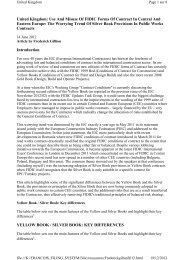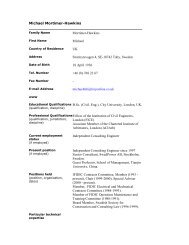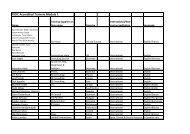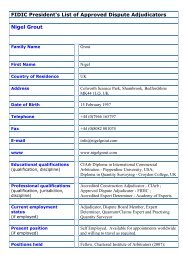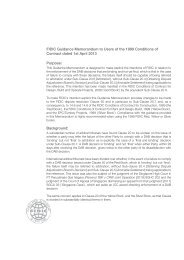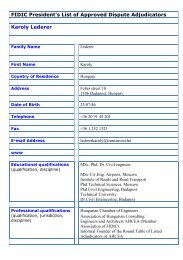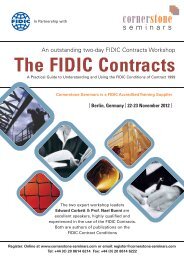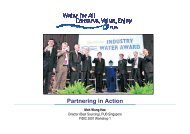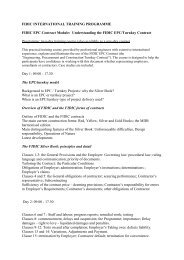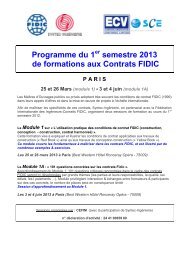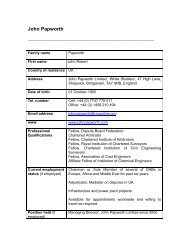Best Practice - Fidic
Best Practice - Fidic
Best Practice - Fidic
- No tags were found...
You also want an ePaper? Increase the reach of your titles
YUMPU automatically turns print PDFs into web optimized ePapers that Google loves.
The project delivery challengeTIMELYDELIVERYFISCALRESPONSIBILITYSOCIETALNEEDSQUALITY &INNOVATION
Our profession is under attack:Lawyers and Accountants claim to beinfrastructure experts• Risk to public health and safety• Emphasis on cost - not quality, not schedule• Short-term term outlook (Focus on initial 1-2% 1of total cost)• Treating consultants as tactical resource – not strategicnecessity• Engineering seen as a commodity: “All are equal”• Declining influence of engineers and architects oninfrastructure, environment and energy decisions
The Weakening an EssentialIndustry• Low price engineering and architecture becoming“cheap”• Industry no longer attracts the “best and brightest”• Tight margins and price-competition competition on mega-projects(Alberta and Boston “big dig”)• New business models (PPP, design-build) pushconsultants down hierarchy• Low price projects results in low re-investment (training,salaries and equipment)• We are becoming “contractors”
The Results:• Engineers, architects and other technicalconsultants are merely tools - no longer the trustedadvisors• Engineering decisions are made by non-engineers(Professional and ethical issues)• Client select technical experts using processesdeveloped by accountants and lawyers forcommodities• Accountants and lawyers rarely follow theseprocesses to hire their own profession• Ultimately, clients are unhappy with results
“It is unwise to pay too much, but it isworse to pay too little. When you paytoo little, you sometimes lose everythingbecause the thing you bought wasincapable of doing the thing you boughtit to do.”John Ruskin (1819-1900)
Engineers Must Respondfor our Clients’ Sakes
Procurement is the Key• Establishing common objectives and agreeing ondesired outcome• Understanding cost-benefitbenefit-risk relationships• Clarifying roles and responsibilities• Selecting the right team for the job (qualifications)• Agreeing on scope• Determining needed resources (fees and schedule)
What’s s Wrong with PriceCompetition?• Rewards firms for using fewer or less qualifiedresources on behalf of the client• Penalizes firms with greater appreciation of theclient’s s needs• Penalizes firms that accurately anticipatecomplications or that propose innovation• Increased life-cycle cost to client, owner andtaxpayer (more changes, higher construction,higher operations and maintenance). Smaller “slice”for Engineers but a bigger “pie” for client.
Project Delivery:The Client’s s Role• Define objectives & requirements• Provide baseline information• Allocate a reasonable budget and schedule• Clearly define expectations for risk sharing and riskmanagement• Develop a procurement process that best achievesclient’s s goals• Clarify scope
Project Delivery:The Client’s s Challenges• Clients need to become knowledgeable and capableof articulating objectives, requirements and scope• Clients need to commit to appropriate budgets &schedules• If the client is not knowledgeable thenknowledgeable staff will need to be found(i.e. “trusted advisor”)• Otherwise client does not know what it wants; whatit is buying; nor what it has received.
Project Delivery:The Consultant’s s Role• Provide practical and innovative solutions• Manage clients’ resources in cost-effective manner• Achieve long-term value and life-cycle savings• Act as client’s s agent in dealing with regulators,contractors and stakeholders• Provide sufficient information and scope of work tocontractor for construction
Selecting a ProfessionalConsultant• The latest InfraGuide “<strong>Best</strong> <strong>Practice</strong>” is for“Selecting a Professional Consultant”(Released, June 2006)• Developed by the public sector, for the publicsector• Working group of nine public sector experts; oneprivate sector participant• Supported by extensive interviews and research• The recommended “<strong>Best</strong> <strong>Practice</strong>” is a competitiveQuality-Based Selection (QBS) process
How Does the“<strong>Best</strong> <strong>Practice</strong>” Work?• Professionals compete based on qualifications andon understanding of the client’s s needs• The client ranks proposals based on ability toprovide the best service and achieve projectobjectives• The client selects the highest ranked firm• Together, the client and selected consultantestablish a detailed scope, including deliverables• Together, they negotiate appropriate fees andschedule that achieve the client’s s goals
Recommended “<strong>Best</strong><strong>Practice</strong>”• Request for Qualifications• Evaluate and Rank Consultants• Request for Proposals• Select Highest-Ranked Consultant• Define Scope• Negotiate Fee Agreement• Award Assignment
Why the “<strong>Best</strong> <strong>Practice</strong>”?• “…encourages clients to view consultants as‘trusted advisors’ who share their priorities andinterest in achieving the best outcome for theproject”• “…it frees consultants to demonstrate how they canadd maximum value to a client’s project rather thanfocusing on how to minimize fees to ‘win’ anassignment”
Selecting Higher Quality• Selection focuses on the quality and level of servicerequired by the client• Ensures mutual understanding of scope andobjectives• Allows sufficient resources for a successful outcome• Innovation is encouraged and rewarded• Better design & design documents (fewer surprisesduring construction and service life)
Selecting More Accountability• Competitive process based on merit andcommitment of resources• Allows creative approaches to risk management andrisk reduction• Fees and scope of work are mutually understood• Fees directly correlate to the services to beprovided• Client maintains control of scope and budget
Focus Upon Long-term Savingsand Life-cycle Costs• Encourages innovation• Provides life-cycle savings that greatly exceeddesign costs• Selection process can be less time consuming andless costly (pre-qualification)• Fewer change orders and fewer disputes (morecost certainty)
The “<strong>Best</strong> <strong>Practice</strong>” isthe <strong>Best</strong> Policy• Competitive and transparent process focusing onquality and long-term value• Life-cycle savings start immediately and can extendover decades• Encourages in-house expertise to represent theclient’s s (taxpayer or shareholders) interests• Permits innovation and sustainable infrastructure
Benefits for Client• The client gets the right team for the right job• More realistic schedules and budgets• Fewer change orders and disputes• Better business relationship between theclient/consultants/contractors/external agencies• Better service, better quality & better value
Benefits for Consultants• “Bait and switch” can be addressed• Local knowledge valid criterion• Sole Source acceptable• Small and local can compete
Who Recommends ThisApproach?• National Guide to Sustainable MunicipalInfrastructure• American Public Works Association• Canadian Council of Professional Engineers• Royal Architectural Institute of Canada• Professional Liability Insurers• Organizations across North America and worldwide
Where is it Used?• This approach is legislated by the US federalgovernment and 44 state governments• The QBS principles reflected in the “<strong>Best</strong><strong>Practice</strong>” are used by municipalities acrossthe US and Canada including:• the City of New York;• the City of Calgary;• the City of St. John’s; and• the City of London, Ontario
Informed Owners Agree“Selecting the right team based on qualifications -not lowest price – ultimately provides the bestvalue and best return on investment”Pete SteblinCity of London (Canada)
Infrastructure Experts Agree“The long-term savings … are far more significantthan the short-term savings provided by the lowestpricedesign”Harold MurphyNational Research Council of Canada
Insurers Agree“This approach to procurement contributes to asound risk management strategy”Peter NeedraXL Insurance Group
Really Smart People Agree“Not everything that can be countedcounts; and not everything that countscan be counted.”Albert EinsteinFamous Genius
The <strong>Best</strong> <strong>Practice</strong> is availablefrom of the Federation ofCanadian Municipalities (FCM)www.thebestpractice.ca or www.fcm.ca/infraguide
Questions/Comments~Thank you~




